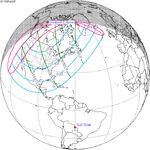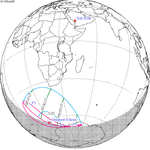Saros 139
This eclipse is a member of saros series 139, repeating every 18 years, 11 days, 8 hours, containing 71 events. The series started with partial solar eclipse on May 17, 1501. It contains hybrid eclipses on August 11, 1627, through to December 9, 1825; and total eclipses from December 21, 1843, through to March 26, 2601. The series ends at member 71 as a partial eclipse on July 3, 2763. Its eclipses are tabulated in three columns; every third eclipse in the same column is one exeligmos apart, so they all cast shadows over approximately the same parts of the Earth.
The solar eclipse of June 13, 2132, will be the longest total solar eclipse since July 11, 1991, at 6 minutes, 55.02 seconds.
The longest duration of totality will be produced by member 39 at 7 minutes, 29.22 seconds on July 16, 2186.[2] After that date, the durations of totality will decrease until the series ends. This date is the longest solar eclipse computed between 4000 BC and AD 6000.[3] Saros series eclipses occur during the Moon's ascending node (a term related to our equator and polar-naming conventions).
More information Series members 24–45 occur between 1901 and 2300 ...
| Series members 24–45 occur between 1901 and 2300 |
|---|
| 24 |
25 |
26 |

February 3, 1916 |

February 14, 1934 |

February 25, 1952 |
| 27 |
28 |
29 |

March 7, 1970 |

March 18, 1988 |

March 29, 2006 |
| 30 |
31 |
32 |

April 8, 2024 |

April 20, 2042 |

April 30, 2060 |
| 33 |
34 |
35 |

May 11, 2078 |

May 22, 2096 |

June 3, 2114 |
| 36 |
37 |
38 |
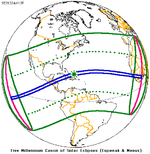
June 13, 2132 |

June 25, 2150 |
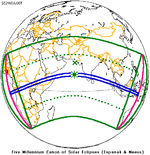
July 5, 2168 |
| 39 |
40 |
41 |

July 16, 2186 |
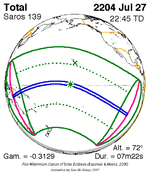
July 27, 2204 |
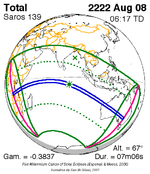
August 8, 2222 |
| 42 |
43 |
44 |

August 18, 2240 |

August 29, 2258 |

September 9, 2276 |
| 45 |

September 20, 2294 |
Close







